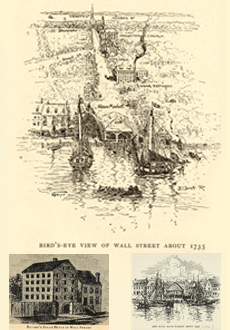The Skyscraper Museum is devoted to the study of high-rise building, past, present, and future. The Museum explores tall buildings as objects of design, products of technology, sites of construction, investments in real estate, and places of work and residence. This site will look better in a browser that supports web standards, but it is accessible to any browser or Internet device.
THE SLAVE MARKET

Top: Frederick Trevor Hill, The Story of a Street, 1908, pg. 28
Bottom Left: The Bank of America, A History of Fifty Feet in New York, 1926, pg. 26.
Bottom Right: Mid-Manhattan Picture Collection, New York Slave Market about 1730, 1902. Retrieved from NYPL Digital Archive.
This 1908 artist's view of Wall Street in 1735 portrays the length of the street and the mixture of uses in the century before it took on its financial character. Most development was clustered towards the East River and its bustling port activity. Visible at the water's edge is a simple peaked-roof structure, the Slave Market, located at the present-day intersection of Wall and Water Streets, that served as the site for the hiring, buying, and selling of slaves.
In the early 18th century, slavery was an important source of New York City's labor force, with 40 percent of white households owning slaves. Continued trade with the West Indies and Britain ensured a growing population of slaves, who were often bought by a ship workers. Slaves would be sent into the streets to find day work, which soon began to spur anxieties among the upper classes. In 1711, a slave market was established at the foot of Wall Street. In 1726, an ordinance was passed declaring the Market House at Clark's Slip the sole public market place for the sale of corn, grain, and meal; from this point, the site was known as the Meal Market, although slaves continued to be bought and sold there. By the mid-1700s, the conditions of lower Wall Street were improving, largely due to the Merchants Coffee House where wealthy merchants often met. These businessmen saw the Meal Market as an obstruction to the agreeable prospects of the East River end of Wall Street and successfully petitioned for its removal. In February 1762 the Meal (Slave) Market was dismantled.
